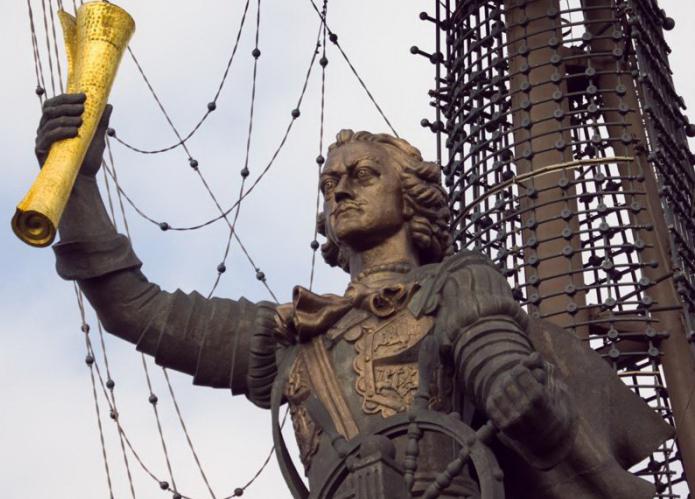Perhaps there is no ruler who deserves the centuries-old memory of compatriots more than Peter 1. The monument in Moscow, designed by the famous sculptor Z. Tsereteli, is considered one of the most controversial creations of the author.
Discussions have not abated around this monument for one and a half decades, it causes a lot of different opinions. In terms of artistic value, it is treated differently. Despite this, as a model of engineering, it is unique.
Description of the monument
Monument to Peter the Great in Moscow is located on a reinforced concrete island, created specifically for its installation. The supporting base of the structure is mounted in stainless steel in the form of a frame on which a bronze cladding is installed. The figure of Peter, the ship and the lower segment of the monument were assembled separately and only after that they were built on a common pedestal prepared in advance.
Peculiarly designed ship guys. They are made of metal cables interconnected and swinging when the wind blows. In other words, the guys are made like real ones.
The monument is lined with high-quality bronze, which protects it from the damaging effects of the environment. The figure of the emperor for additional protection is covered with a special varnish that contributes to the preservation of color.
Sails of the ship are made hollow to facilitate the upper part of the monument. Their basis is a light metal frame. All the fixtures of the monument are made of stainless steel to prevent corrosion. Inside the monument there is a staircase designed for restorers, installed to assess the internal state of the structure.
As already mentioned, the bronze king stands on an artificial island. To simulate the movement of the ship along the waves, fountains are equipped at the base of the island. When you look at the composition it seems that the ship cuts through the waves.

History of creation
The bronze statue was erected in 1997. Many media claimed that this is a monument dedicated to the 500th anniversary of the discovery of America by Europeans, and initially the figure of Christopher Columbus was supposed to be on the pedestal .
However, the author’s attempts to sell the monument to the Americans or Spaniards were unsuccessful. After that, the monument was presented by the authorities and the author to the city as a gift in honor of the 300th anniversary of the Russian fleet. As a result, Peter the Great became the hero of the composition. The monument in Moscow still causes heated debate among the public and experts. The fifth of September 1997 was marked by the discovery of the statue, dedicated to the celebration of the 850th anniversary of Moscow.
Moscow accepted the monument to Peter I without enthusiasm, primarily because the fleet’s anniversary was held in 1996, that is, the gift was “late” for a whole year. Navy employees in the person of Admiral Selivanov turned to the Russian government with a request that another monument be erected in the capital in honor of their professional holiday, according to a sketch by artist Lev Karbel. However, the city authorities ignored the request of the sailors.
The attitude of Muscovites to the monument
Most residents of the capital are confident that the giant statue of the emperor has little artistic value and does not fit into the architectural ensemble of the city.
In world culture, there are many cases where unusual or strange sculptural compositions glorified their heroes and authors. For example, the Wenceslas monument on a dead horse, located in the center of Prague, the Haddington pedestal, depicting a shark crashing into the roof of a house, or a well-known Brussels pissing boy. Russia, Moscow can also boast of their attraction in the same way . Monument to Peter I in Moscow entered the world top ten most "unsympathetic" structures.
Monuments in other cities
Tsar Peter left the greatest mark in the history of our Fatherland as an extraordinary reformer, ruler, military leader and, undoubtedly, a great despot. Not only Moscow and Petersburg are famous for Peter's monuments.
Monuments to Peter are in Kaliningrad, Voronezh, Vyborg, Makhachkala, Samara, Sochi, Taganrog, Lipetsk and even in European cities - Riga, Antwerp, Rotterdam, London.
Several volumes are not enough to tell how much Peter 1 did for Russia. The monument in Moscow and other cities will preserve for many decades the appearance of the greatest of the Russian monarchs.
A few words about the author
The famous sculptor and artist Zurab Konstantinovich Tsereteli was born in Tbilisi, in 1934, three days before Christmas. He received his higher education at the Academy of Arts of Tbilisi. Then he studied in France, where he met with outstanding painters - Chagall and Picasso.
The 60s in the life of the sculptor marked the beginning of active work in the monumental genre. One of the famous brainchild of Tsereteli is considered to be "Peter 1" - a monument in Moscow. His works are known not only in Russia and the CIS countries.
Tsereteli's sculptures are available in America (“Tear of Sorrow”, “Good conquers evil”), Great Britain (“Destroy the wall of mistrust”), Spain (“Victory”).